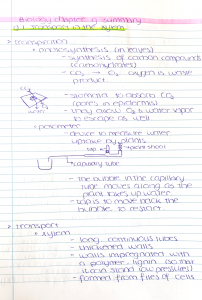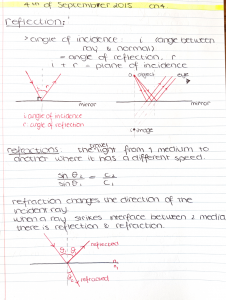As described in the ‘Tips to Make IB a Piece of Cake’, good notes are really important, not only in revision or assignments, but taking good notes will help you memorise the material straight away.
Important in taking notes is that you need to be able to recognise what the notes are on, for what subject it is, when they were from, that they are legible, etc. A good thing to have in your system is to be consistent when you do this. Being consistent will help you recognise your notes, which is helpful when revising for exams. Below you will find some tips for doing this and some examples of my own notes:
Headings: Whether you are taking notes on paper or digitally, during class or when writing summaries in preparation for an exam, start with a title that reflects the topic you’re on. When the teacher is covering chapter 4 today, write that on top. If you know the name of the chapter, or sub-unit, even better! Add that too! This will help you finding your notes back and grouping similar topics together.
Highlighters: When taking notes in class, start by highlighting the first free line of the notebook (where you will start writing notes). I personally like to use the same colour highlighter for a subject to stay consistent. The highlighted line indicates the start of this lesson’s notes.
Dates: In this highlighted line, write the date, subject and chapter you are covering. This is helpful later on when you are trying to find notes back and only remember certain details, like the day it was taught on. It will also help you to put things in order later on and in general it is a very nice way of filing your notes.
Keep writing! Probably a very logical tip but just keep writing during a lesson. If your teacher uses a slideshow then copy what’s on there, even if a slide comes up with stuff you already now. It makes your notes more complete if you copy everything or remind yourself of the things that were taught that day.
Missed something? If you missed something during the lesson because your teacher flipped the slides really quickly, ask them to go back, or when that is not possible, write it in your notes too. I tend to write square brackets and then the slide number or if unknown, just three dots. This will remind me that I missed information that belonged in between, so that I know where to look after the lesson, or what to ask for.
Neat! A fairly logical one next: write neat, and try to maintain this throughout your notes. Of course you are going to get sloppier down as the lesson or session progresses but try to maintain a nice looking handwriting. It makes your notes not only better legible, but if you glance over the piece of paper next time, it will look more appealing. This lowers the boundary for you to start reading the notes and revise them!
Draw: Make drawings. If the lesson is going fast and you do not have time to write everything down, summarise it in a drawing, a flow-chart or a mind map. These are all ways of categorising information fairly quickly which is helpful for you to make sure you do not miss information or key terms, show relations between information or concepts and at least you have written down all, or most of the terms that were relevant to the lesson. If you are then unsure about something, you have the appropriate term to ask for more information.
Below you will find some (biology) summary notes and some (physics) class notes:


